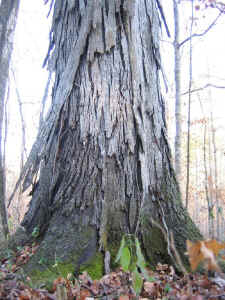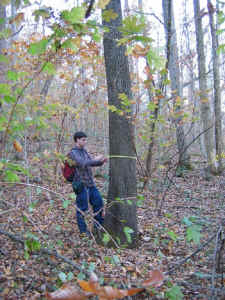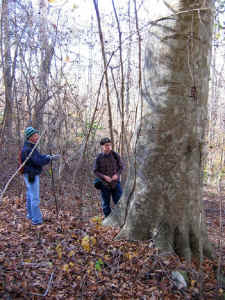Red
Mountain, Alabama, November 2005
Several months ago Bob Leverett and I received an email from
Larry Brasher,
a professor at Birmingham Southern College. His family has owned
a tract of
land in northeast Alabama for 140 years, and he invited ENTS to
visit and
survey the old-growth forest it contains and to measure the
current National
Champion southern shagbark hickory also on the property. Being
considerably
closer than Bob, I went to the property with Jess Riddle
November 17-19th.
We were
excited to meet Larry and the southern shagbark hickory and to
take
part in the first concentrated ENTS trip to Alabama. This was
also a special
trip in the sense that it was one of the few ENTS trips to a
private
property, and one solicited by the owner. We were honored to be
contacted by
Larry and so hospitably received and housed in the ancient
Brasher
farmhouse- complete with trees planted by the family more than
130 years
ago. It seemed every tree had a history and an anecdote
associated with it.
Larry was deeply connected to the property and is a strong
advocate for its
continued preservation and the creation of a conservation
easement. His
intimate knowledge of the property and individual trees coupled
with his
extensive botanical knowledge made the trip immensely rewarding.
Larry is
the quintessential ENTS, and his passion shows freely in his
actions and
words. Jess and I could not have had a better guide or
experience there.
 Jess Riddle and Will Blozan
Jess Riddle and Will Blozan
measuring the "huge" bottlebrush buckeye in Brasher Woods with various
poles and tapes on a limestone precipice. The tree is 11", and
22.8' tall
with an average spread of 14.3' and maximum spread of 15.7' - photo
by
Larry Brasher
The Brasher property is on Red Mountain, a foothill ridge
paralleling the
Cumberland Plateau rising nearly 500 feet above the valley
floor. Greasy
Cove, approximately 12 miles long, is drained by Clear Creek,
which
traverses the Brasher Tract. Brasher Springs is a gorgeous
natural spring
that boils out of the ground at the rate of up to 100,000
gallons per hour.
The water is pure and crystal clear, but at 59 degrees
year-round makes you
think twice about taking a dip!
The Brasher Tract, referred to by the family as "the big
woods" is a 50 acre
old-growth forest in private family ownership since 1866. Only a
small
section of the forest was disturbed when the land was out of the
Brasher
family for 20 years (ca. 1905). Tuliptrees- the "one log
per truck" kind-
were cut on the lower slopes but the surrounding oak-hickory
forest was left
undisturbed except for some cutting of downed chestnut for fence
posts in
the 1940's.
According to the Alabama Natural Heritage Program, the Brasher
woods are
"The finest old-growth hardwood forest remaining in the
state of Alabama".
In fact, the tract is the type site for the "Southern Ridge
and Valley Basic
Mesic Hardwood Forest" (Milo Pyne, International
Classification of
Ecological Communities, 2003).
The site is unusually rich in plant diversity, including 20
species of ferns
and 11 orchids! In our short time there Jess and I measured 36
species of
trees and 3 species of shrubs. This diversity is due in part to
the
calcareous nature of Red Mountain. Chickamauga limestone is
present at the
base of the slope by the creek, followed by Sequatchie and Red
Mountain
formations successively to the top of the slope, the latter a
sandstone.
These distinct layers of rock are revealed at the surface by the
vegetation.
Larry has been studying the extensive communities of an
extremely rare plant
that at present lacks a generally known common name. Pending his
forthcoming
paper which will reveal some local and traditional names, I will
refer to it
simply as Croomia pauciflora. This rare herb in the Stemona
family occurs on
Red Mountain as a disjunct population. Larry has found that this
plant may
be associated with a particular stratum of rock, which is
abundant on his
property. Of the known populations in the state, the largest
occurs on the
Brasher property, and on adjacent tracts of Red Mountain
recently surveyed
by Larry.

Bark detail, southern shagbark hickory
National Champion - photo by Will Blozan
We began our survey on a crisp 24 degree morning. One of the
showcase
species of the property is southern shagbark hickory (Carya
carolinae-septentrionalis). Larry nominated the current National
Champion
which was one of the first trees we measured. We found the tree
to have
grown 2 inches in girth but it "shrunk" in height by
23 feet once the laser
numbers were calculated. Still, at 127 feet tall it was an
impressive
specimen and one of the tallest on the property. To confound the
identification of this unusual species, the "ordinary"
shagbark hickory (C.
ovata) was present at times only yards away and sharing the
canopy.
Mockernut, pignut, and bitternut rounded out the hickory
species, all of
which reached impressive sizes.
The oaks
were the next most abundant group with at least 10 species
represented. Chestnut oak was the most common, with northern
red, white,
chinquapin, shumard, black, and scarlet also present. The
location of a
Saul's oak (Quercus x saulii) on an adjacent site added to our
suspicion
that it is a very common natural hybrid that is likely
omnipresent in
forests with extensive populations of white and chestnut oaks.
Jess and I
routinely find them.
Other common
species included Florida maple, American beech, tuliptree,
white basswood, common paw-paw, hop-hornbeam, red bud, dogwood,
red
mulberry, black walnut and chalk maple. Several species of
hawthorn, plums,
oak-leaf and woodland hydrangea filled the shrub layer. The most
common
shrub was by far bottlebrush buckeye (Aesculus parviflora) which
formed an
omnipresent and dense thicket nearly throughout the property.
Many were
covered with a large white scale which could be as wide as the
stem they
were feeding on. The diversity was astounding and I was
instantly
overwhelmed with so many new species in such close proximity. We
may have
located a rare shrub species not previously known to the
property, Hydrangea
arborescens ssp. discolor. I thought at first it was ssp.
radiata which is a
bright white under the leaf surface, but it is more likely the
ssp. discolor
which is characterized by a gray underside. I am not sure of the
current
taxonomic splits of these subspecies but it may or may not be
significant.
Very little American chestnut debris was seen but sprouts were
present along
with Allegheny chinquapin. We measured a tree being studied by
the American
Chestnut Foundation that appears to be a hybrid of both species.
It has the
bark and growth form of Allegheny chinquapin but the leaves are
much larger
and more lanceolate and deeply toothed than "typical".
The tree is not
considered an American chestnut or hybrid at this time so we
will list it as
a chinquapin (although the name "chinq-nut" was used
during the day when we
encountered more.). The tree we measured set a new eastern
height record of
49'.
After the battery in my rangefinder warmed up we were off in
typical ENTS
style, measuring all we saw and running here and there
exclaiming for the
other to come and see what we had spotted. I'm sure Larry had no
idea what
he was in for and thought we would never get off the mountain.
Well, he was
close- we did not leave the mountain until dark having spent the
entire day
from sun-up to sundown measuring, measuring, and measuring. I
think Jess and
I set a new record for the most trees of the most species
measured in one
day- and many "new to science" in the sense that they
had never been
measured before as a species or for the state. It was thrilling!

Larry and the big Devils-walkingstick, Fitzhugh Woods
- photo by Will Blozan
|

Tall persimmon, Fitzhugh Woods - photo by Will Blozan
|
We actually visited two sites on Red Mountain, the other being a
tract once
owned by the Fitzhugh family. This tract was
"discovered" by Larry on a
Croomia survey. It was smaller and more disturbed than the
Brasher Tract but
nonetheless contained some very impressive trees. We found a new
state
champion Devils-walkingstick (Aralia spinosa) and a tall
persimmon that
reached 112.8'- just a few feet shy of the tallest known to
ENTS. One cove
contained a huge pignut hickory and immense American beech that
towered over
124'. Jess was floored by the chinquapin oaks, and one was
measured to a new
record height of 121'.

Giant beech, Brasher Tract - photo by Will Blozan
|

Giant pignut hickory, Brasher Tract - photo by Will
Blozan
|
Conversations
went on into the night and excitement was building for the
trip the next day into the Bankhead National Forest with the
locally famous
Lamar Marshall of Wild Alabama (Jess will post a separate
write-up on that
GREAT trip.)
The first day's tally was exciting and presented the first
Rucker Index for
the state, a very respectable 132.9. This site is now the
tallest
family-owned forest ENTS has thus far surveyed. Here is the line
up for
Brasher Woods:
|
Species
|
Height
|
|
Carya
glabra
|
143.23
|
|
Carya
ovata
|
140
|
|
Liriodendron
tulipifera
|
138.54
|
|
Carya
carolinae-septentrionalis
|
135.37
|
|
Quercus
montana
|
132.38
|
|
Tilia
heterophylla
|
132.31
|
|
Fraxinus
pennsylvanica
|
132.26
|
|
Liquidambar
styraciflua
|
127.7
|
|
Quercus
rubra var. rubra
|
126.5
|
|
Quercus
muehlenbergii
|
121.08
|
|
Rucker
10
|
132.93
|
Fitzhugh's
Woods, with its more disturbed character has a lower Rucker
Index, but contained some taller species or specimens that bring
the Red
Mountain Rucker Index to over 134. Curiously, common persimmon
made it onto
the list!
|
Species
|
Fitzhugh
|
|
Species
|
Red
Mountain
|
|
Carya
glabra
|
144.42
|
|
Carya
glabra
|
144.42
|
|
Carya
ovata
|
138.77
|
|
Carya
ovata
|
140
|
|
Liquidambar
styraciflua
|
137.6
|
|
Liriodendron
tulipifera
|
138.54
|
|
Tilia
heterophylla
|
130.5
|
|
Liquidambar
styraciflua
|
137.6
|
|
Fraxinus
pennsylvanica
|
130.35
|
|
Carya
carolinae-septentrionalis
|
135.37
|
|
Fagus
grandifolia
|
125.8
|
|
Quercus
montana
|
132.38
|
|
Quercus
montana
|
123
|
|
Tilia
heterophylla
|
132.31
|
|
Quercus
alba
|
120.84
|
|
Fraxinus
pennsylvanica
|
132.26
|
|
Quercus
muehlenbergii
|
113.6
|
|
Quercus
rubra var. rubra
|
126.5
|
|
Diospyros
virginiana
|
112.8
|
|
Fagus
grandifolia
|
125.8
|
|
Rucker
10
|
127.768
|
|
Rucker
10
|
134.518
|
It
was very interesting that tuliptree did not do its usual
domination of
the Rucker Index. In general, the representative specimens on
the site were
relatively short even though they were old enough to have grown
much taller.
We can only guess at the dimensions of the trees logged in the
early 1900's.
But based on the similar performance of the tuliptree in the
Bankhead
National Forest the species is certainly out of its prime
growing sites and
conditions.
As far as the Rucker Index goes, the Brasher Tract is
exceptionally
impressive given the lack of any conifer components. Very few
high Rucker
sites (>130 RI) ENTS has measured lacks a conifer component.
In comparison,
the Montpelier Estate, with its Rucker Index of 135.07, has but
one conifer
which is just second from the lowest value and will be quickly
supplanted by
more hardwood measurements. Furthermore, the Brasher Woods has a
span of 22
feet between the tallest and the lowest species, as compared to
over 48 feet
in Montpelier. Since the Rucker Indices of the sites are so
close, this
suggests a higher diversity of tall trees in Brasher Woods than
Montpelier
even though the tallest tree in Brasher Woods is fully 25 feet
shorter than
Montpelier.
The bottom line is that Brasher Woods is an exceptional forest
of extreme
diversity in both species and dimensions. It is also
exceptionally well
preserved and suffers from few exotic specie invasions in the
"Big Woods"
section. Larry said he brings his classes up to the property to
manage
exotic encroachment (oh, what a job that would be!) on the more
disturbed
lower section, and as Jess and I traversed the property we
pulled Chinese
privet and Japanese barberry.
In summary, the Red Mountain sites we sampled exceeded any of
our
expectations. In fact, pending the collection of a few spread
measurements,
we found 11 state champions between the two sites; three other
record-sized
species were spotted but not measured. The depth of tall trees
of many
species blew us away. For eight species, the tallest known
representatives
grow on Red Mountain and three others are just a few feet taller
on other
sites. These forests are holding their own with respect to other
ENTS
surveyed sites, and contribute heavily to the state of Alabama
having a high
Rucker Index of 139.8. A Rucker Index so high after just five
sites sampled
hint at the potential ENTS has yet to discover. We have not yet
seen good
habitat for eastern hemlock, eastern white pine or tuliptree.
Naturally, the
coastal swamp and floodplain forests should yield some tall
trees. A low to
mid 140 Rucker Index is certainly within the realm of
possibility.
We extend our sincere appreciation to Larry Brasher and his
family for
inviting ENTS to survey "the big woods". Without his
keen eye and deep
devotion to the land these mountain treasures would be forever
lost and
relegated to being the subject of imaginative speculation. It is
a pity how
few sites like these exist, and more so what has already been
lost. The
Brasher family has ensured that we will know these places as
they were, and
with proper management, will remain so into the future.
Thank you Larry!
Will Blozan with Jess Riddle
|